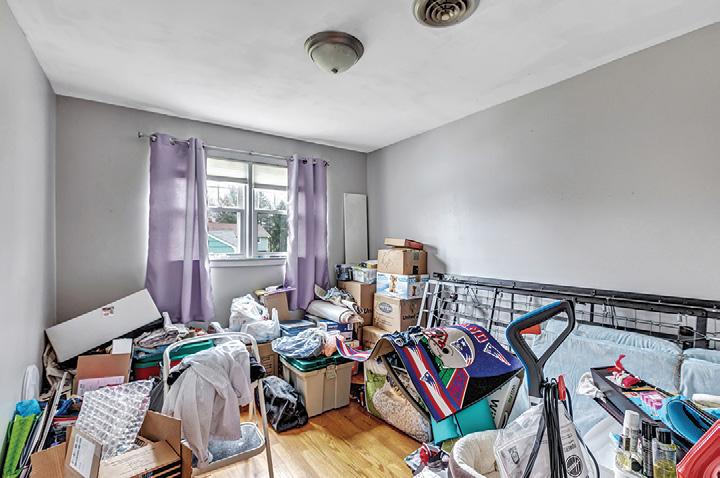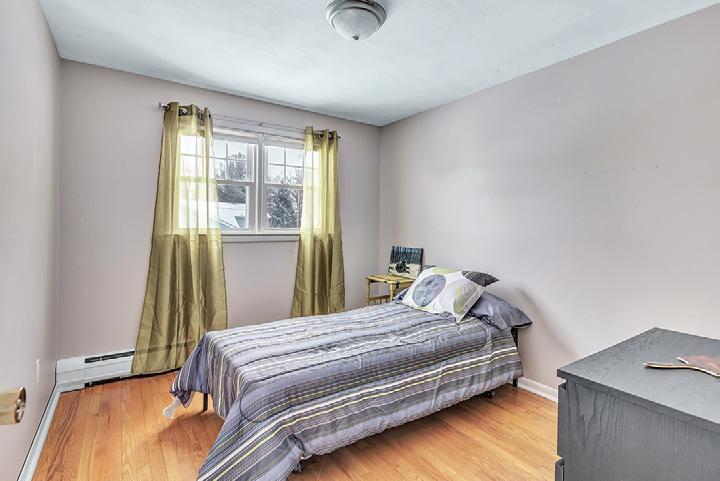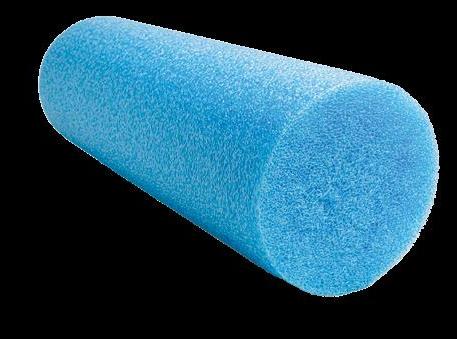
11 minute read
HEALING ROOMS
Making Room for Sustainable Self-Care
by Joan Law and Ariana Fine
Advertisement
Creating a life you don’t want to run away from includes creating spaces within our homes for self-care. Focusing on areas such as the bedroom, kitchen and repurposed rooms can help us further our healing journey using feng shui principles. The practical, intuitive art is used to bring individuals and their environments into harmony. It works with the system of the five elements and the principle of chi, the vital energetic force present in all beings and things.
Restful Energy in the Bedroom
The bedroom is our space to rest and rejuvenate. Certain items can keep the energy circulating in the room when it should be a peaceful place. For instance, stacks of books by the bedside creates a sense of not having the time to read them all. Remove items from the bedroom such as mirrors, televisions, items under the bed, laundry, paperwork and electronics as much as possible. Even putting the cellphone on a bureau so that it is not easily accessible from the bed will help. Pictures of children should not be in the bedroom; it is not that we are not thinking of them, it is more the visual reminders that we worry about them, and the anxiety and stress that might cause. The bed placement is important. Try not to have it under or in front of a window as that symbolizes lacking support. Position the bed where the door can be seen so we can see who is entering. Another simple tip is opening and closing the curtains in the bedroom or living room. This ritual at the beginning and ending of the day can make a difference in our perception of the day’s progression. Making the bedrooms fit the people is another concept that can help familial energy. If, for instance, there are three boys sharing a bedroom when the parents are in the bigger room, it may make sense to rearrange the bedroom allocations. Use the house the way it works best for the whole family.
The Right Space to Cook at Home = Healthier Eating
As we strive to be healthier, our kitchen can reflect our emotional clutter and health difficulties. The supplements and kitchen equipment we use for special diets can take up space. The cluttered counters then become a stressful, visual reminder for the family of the impact the diet may be having on family financials. Clearing out cabinets from infrequently used things, such as extra mugs, makes space to put away the constant dietary reminders and declutters the countertops. Other tips include ensuring plenty of room on the counters for food prepping. Keeps snacks behind closed doors; if we don’t see them, we are less likely to eat them so readily. “Having an organized, decluttered, kitchen with good flow and full of nutritious food makes eating so much easier and encourages healthier habits,” said Diana Pruzinsky Abata, CHC, AFMC (DianaPruzinsky.com). Hoarding food, which can support a feeling of not having enough and living fearfully, is an interesting topic as some people like to be prepared for the future with sufficient supplies. There is a difference between buying on sale where many items then go bad or expire before they are used and long-term, healthy storage of food.
What’s the Purpose? Rethinking How Rooms are Allocated
Look at the home through feng shui “eyes” to reimagine spaces that may not be used frequently or optimally. Just because conventional thought say a room’s purpose is supposed to be one thing doesn’t mean it has to be. Live in a space that is comfortable and efficient for the family. A spare room that is “saved” for infrequent guests could be repurposed as a self-care space to bring peace, healing and rejuvenation to the people actually living in the home. Remember that we are trying to create the space for the activity we want more of, so don’t just fill it with “something.” Wait for the perfect item for the space. For parents that lament that their

Guest Bedroom Before

Guest Bedroom After
grown children or family never visit, take a look at their room or the guest room in which they would stay. Are the rooms treated as a storage or big closet room? Use that space with intention; is it an inviting room ready for guests? Many of us need to face the retention of “things” and the patterns of unwillingness to let them go. The physical action of releasing is part of a healing process to create pathways in the brain for other things that we need to release. Strengthening or loosening the “muscles” of letting go can change the way we look at life in general, whether it is about people, jobs or other life elements that are no longer serving a productive purpose for us. “A health concern prompted me to call a feng shui practitioner again. My home office was really out of control. I’d convinced myself ‘the clutter didn’t bother me.’ I needed to change my space to support a healthier lifestyle,” said Kara Flannery. “After we finished that office, I suddenly felt lighter. I realized how much energy it had taken me to ‘block out’ the clutter each day so I could focus on my work. I was spending several hours a day in a room that was just weighing me down and holding me back. Now, I work in a room that inspires me.”
All That Stuff!
Many of us retain things because we don’t want to throw them out or we want to save them for others. This is especially apparent with parents and grandparents. Those items take up space physically and energetically. It can help to work with family members on a list of what they really want to save and what is truly important to the parents and grandparents. Empty nesters may also need to think about whether they will sell and downsize; that requires sifting through what is more important. Getting comfortable with small, feng shui changes prepares them for making the bigger life changes coming. A house can be cluttered with things that aren’t relevant to the current life we are living, such as a retired nurse with scrubs or a lawyer with college textbooks. We may be saving the good china sets and party gear but no longer host formal parties. Or we may be a parent keeping so much of our kids’ artwork. Consider what we see as we enter the house. Are the entrances cluttered or stressful to look at? Do they feel welcoming when the family returns home? Do they reflect who the family is? Learning the lesson of buying with purpose and of donating that which we don’t need can help us change our behavior to be more intentional in how we design the healing spaces we live in.

Breezeway Before

Breezeway After
Joan Law, a Stratford-based certified feng shui consultant and clutter clearing expert, owns Feng Shui Joan’s Way, which provides decluttering, downsizing and real estate staging. Connect at 203-260-7770 or FengShuiJoansWay.com.

ON A ROLL
Foam Rollers Ease Pain and Workout Recovery
by Marlaina Donato
Foam rolling— rolling parts of the body on top of a lightweight foam cylinder—targets trigger points or painful knots in muscles and is a valuable tool for reducing chronic pain and enhancing workout recovery. From sciatica to pelvic floor dysfunction, there is a foam roller for almost every condition, including low- to high-density, heated and textured types for massage-like benefits.
Research during the past several years shows that using foam rollers before or after exercise quells fatigue, improves joint mobility, lowers risk of injury and eases muscle soreness. Its effectiveness is attributed to the activation of the central nervous system resulting in better circulation and reduced inflammation.
“Foam rollers are used to relieve tension in the fascia (connective tissue), ‘roll’ out sore muscles and provide a soothing, self-controlled, soft-tissue massage,” says Amber Kivett, owner of Kivett Kinetic Solutions, in Monrovia, Indiana. “They can also be used for proprioception, balance, flexibility, core stability training and most importantly, natural pain relief.”

Freeing the Body
Fascia, the body’s all-pervasive connective tissue, tightens like an invisible net from injury and other stresses and can adhere to the underlying muscles, creating pain and restriction. “Foam rolling has the power to change and realign the 12 fascial lines responsible for human movement and support,” says Kivett. “Those same fascial lines also sense and transmit pain and emotion far greater than any nerve or muscle and respond well to foam rolling. There’s an emotional and spiritual release in the body when fascia is compressed and released. That response facilitates a structural change to human alignment and an immediate change in pain levels for all types and causes of pain.”
Foam rollers offer an opportunity for self-care, according to Los Angeles fitness trainer Ashley Borden. “Foam rolling is one of the best ways to troubleshoot your own body, keep it healthy and mobile. Using an inexpensive tool like a foam roller not only feels good, but it also connects you to your body. Foam rolling the entire body encourages circulation and an immediate feeling of relief afterwards. My clients who don’t like to work out are usually surprised how good they feel post-rollout and feel encouraged to do more.” She cites research that shows that a dynamic warm-up, paired with the use of foam rollers before and after workouts, amplifies recovery and aids in the repair of muscular micro-tears.
For Rafal Augustynowicz, founder of TeamRAF Fitness, in Kent, England, it’s about counteracting lifestyle stresses. “The foam roller is a beautiful and great tool, especially in the 21st century, when we sit too many hours. It is a great tool to get our mobility and our posture back to normal.”
Recovery, Joint Pain and Sciatica
Gently rolling targeted muscles below and above specific joints can help to resolve certain types of pain, including in the knee. “Many times, when a person has pain in the knee, it’s more than likely they have
tight muscles elsewhere—calves, inner thighs, hip flexors or glutes—and the pain shows up in the knee,” says Augustynowicz. “Foam rolling and using a massage ball have saved me many times when I had a lot of problems with my back, neck, hip and a dislocated shoulder.”
The practice can help ease sciatica, a sometimes-excruciating condition. “Most cases of sciatic pain are caused by tight muscles deep in the buttocks, including the piriformis muscle,” says Kivett. “The sciatic nerve travels through the piriformis, so if it’s tight, it will cause a sensation similar to that of sciatica nerve pain. A foam roller can be used along the back, throughout the buttocks and the legs to relieve tension, soften tissues and calm the nervous system for instant pain relief.”
Kivett, who was introduced to foam rollers during intensive physical therapy after a life-altering accident, found them to be a way to recover from severe fibromyalgia pain. “My nerves were hypersensitive from the injuries, and I used foam rolling to reboot the ‘software’ in my brain, which allowed me to engage in recovering.”
Foam rolling is an all-around boon, Borden highlights. “The immediate relief, the muscle definition, the decrease in cellulite, all of these are added benefits.”

Marlaina Donato is an author and composer. Connect at AutumnEmbersMusic.com.
MORE ADVICE FROM THE EXPERTS
what to know before a roll Amber Kivett: Ideally, it’s best to perform foam rolling right after a light warm-up for five to 10 minutes to increase circulation to the muscles and decrease tension and stiffness. If there is extra time, do a quick three to five minutes of foam rolling after a workout, but preferably after you’ve done your cool-down or some walking. You don’t have to foam-roll the entire body post-workout; just do a quick “scan” of areas that are more sensitive or painful. For those with high levels of pain, fibromyalgia, MS, autoimmune conditions or an acute injury, I would recommend buying a low-density, soft, foam roller or [one] that vibrates, because soft and/or vibrating foam rollers are gentle to fragile areas.
Ashley Borden: Foam rolling is a valuable tool for the senior population to improve overall body tightness and circulation. Assistance is needed if you have a hard time getting up and down. I would also suggest a non-slip yoga mat and using the softest foam roller first to gauge the pressure. If you feel like you have to hold your breath when you are foam rolling, the surface is too hard. Rafal Augustynowicz: Never use foam rollers on bones, joints, the spine or armpits; only on the muscle/flesh. Be informed to avoid arteries, etc. If it hurts too much, it’s probably not right. Watch tutorials or go to a professional.
Professional Printing Reliable Customer Service

594 Blakeslee Blvd. Dr. W. • Lehighton, PA 18235 P: 800.443.0377 - Ext. 3104 • C: 570.606.6975 E-mail: mgriffith@tnonline.com www.tnprinting.com
Maintain your youth
with Homeopathic HGH Transdermal Gel Maximum Strength Somatropin
Unique and affordable alternative designed to support your pituitary gland! Usage may
• Improve Bone and Joint Health • Improve Sleep • Increase Muscle and Reduce Fat Contact Shirley R. Bloethe 860-989-0033 or www.PassItOnLLC.com








